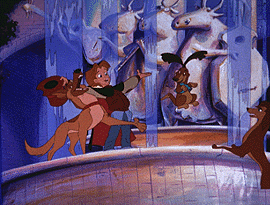Review by Frankie Kowalski
Unlike most sequels, All Dogs Go to Heaven 2 , directed by Paul Sabella and Larry Lerker, is clearly better than the 1989 Don Bluth original. This tale of how Charlie Barkin (voiced by Charlie Sheen) gets to go back to earth to retrieve Gabriel's horn, has considerably more substance, is certainly more comprehensible and the art direction of Deane Taylor really captures the essence of San Francisco. Yet, despite its virtues, it suffers from a problem endemic to many studios trying to cope with a worldwide shortage of animation artists while working with small budgets and having big "Disney dreams."
All Dogs Go to Heaven 2 begins with our scoundrel Charlie totally bored with heaven's nothingness and yearning for earthly adventure. Fallen Angel Carface (Ernest Borgnine) steals Gabriel's Horn (without it the gates of heaven can't open) and becomes a sidekick to Satan's helper, Red-a cat (George Hearn). So Charlie and Itchy (Dom DeLuise) go back to earth to rescue the horn as well as befriending an 8-year old runaway boy, David (Adam Wylie). Charlie is also charmed by a sassy Irish setter Sasha La Fleur (Sheena Easton) who follows along as if she were his alter-ego. Charlie rediscovers, through this mischance adventure, his compassionate soul and in the end he prevails over evil.
Writer-producers Mark Young and Kelly Ward should be commended for giving the story considerably more validity the second time around for the original characters Charlie Barkin, Itchy, Carface and Annabelle (Bebe Neuwirth). The film's songs by Barry Mann and Cynthia Weil revealed more about the characters as well. My favorite song was "Count Me Out" performed by saavy Sasha (Sheena Easton), as she makes her entrance in a canine dive.
 Andy sings in the streets
of San Francisco with his new pals, Charlie Barkin, Itchy, and Sasha in
All Dogs Go To Heaven 2.
Andy sings in the streets
of San Francisco with his new pals, Charlie Barkin, Itchy, and Sasha in
All Dogs Go To Heaven 2.The original film seemed to have suffered both from Bluth's inability to tell a story and a rampant perfectionism that often ends up making his films more confusing than not. For instance, if you saw All Dogs Go To Heaven, I think you have a good idea of what I'm talking about. Scenes seemed to have been added and/or taken out without any explanation. For example, the girl wins lots of money gambling with Charlie and Itchy and buys all new sets of clothes; then, in the very next scene she still has her rags on...
I just don't get it???
All Dogs Go To Heaven 2 does display inconsistencies of a different sort. This time, as a result of what sometimes occurs when dealing with multiple studios around the world. At least that's the only way I can explain why characters went from opaque to transparent and back again within the scene; or why the colors would be bright and vivid in one shot, only to become overcast in the next! I'm sorry to say that I walked out of the theater almost thinking I needed new glasses--and I am already very nearsighted. I guess the only saving grace during this task was that they used my favorite color purple throughout the movie.
Perhaps a good part of the problem stems from the fact that their main studio, Screen Animation Ireland (Don Bluth's old studio in Dublin), went out of business and could not finish the film. As a result, MGM had to do much more subcontracting than anticipated. The worse part was that this happened towards the end of production, when about 90% of the film had already been animated. Trying to finish a film under these circumstances, given the tight labor market and the worldwide boom in animation, was probably something of a nightmare.
It is for these reasons, among others, that the Hollywood majors have invested so heavily in building their own in-house studios, where they can control every aspect of the production process--despite the extra costs involved. MGM, which started its modest animation division only a few years, is still recovering from its receivership by Credit Lyonnais.
Despite all of its dilemmas, it's nice that MGM Animation has entered the feature film emporium and won't be discouraged from further attempts at theatrical films.
Frankie Kowalski is Associate Editor of Animation World Magazine and is a regular contributor to ASIFA-Hollywood's newsletter The Inbetweener.